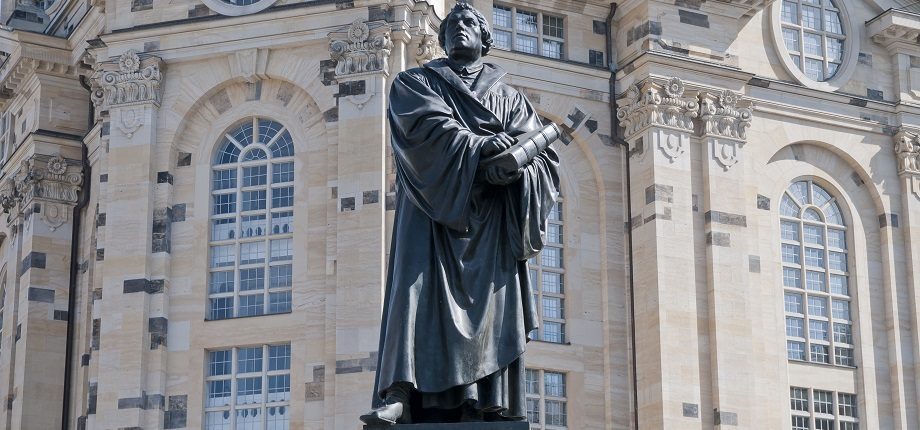Editor’s note: the following is part of a series of articles from ELCA theologians, Rostered Ministers and seminarians/professors and features individual viewpoints on the Reformation’s importance on the occasion of the 500th anniversary. This article reflects the perspectives and thoughts of the author and not necessarily the theological, ethical, or social stances of the Evangelical Lutheran Church in America or Living Lutheran.
100 years ago, in 1917, any celebration in the United States of the 400th anniversary of the Reformation was tinged with questions about Martin Luther’s German-ness, given that we had just entered into World War I against the Prussian kaiser. That year East Coast Lutherans collected money to erect a statue in a Philadelphia city park commemorating not Luther but Henry Melchior Mühlenberg, the founder of the first pan-Lutheran church organization in the United States, only to be turned away by the city fathers, who wanted nothing to do with honoring any German. True, the Philadelphia Orchestra played Mendelssohn’s “Reformation” symphony in the fall, but other attempts to commemorate the Reformation were swallowed up by the war.
Today, the country has replaced anti-German sentiment with other bugbears, and yet the question of how to remember the Reformation after 500 years still puzzles U.S. Lutherans. The image of Luther nailing a piece of paper to a church door continues to attract attention, even by those who have never read his “Ninety-five Theses.” In the comedy cartoon, “The Simpsons,” some years ago, Lisa Simpson tried to grow a miniature city in a terrarium. As she looks on from outside the glass container, a figure clad in black approaches the church door and nails something to it. “Look,” she cried, “I’ve created Lutherans.” But such scenes (and many others like them) only serve the Reformation’s iconography and mythology but leave the actual event and its originator’s intent in the dark.
As interested people prepare to commemorate the 500th anniversary of the Reformation, it would serve them well to pierce the cloud (or halo) surrounding Luther and his “Ninety-five Theses” and learn what Luther was saying and why that still matters today. In doing so, we may discover how much Luther still has to offer Christianity, as challenging as his thought may be.
Luther’s chief concerns
On Oct. 31, 1517, Luther wrote a letter to Archbishop Albrecht of Mainz complaining about the sale of indulgences in Albrecht’s territories. To this letter, now housed in a Swedish archive, he appended a copy of 95 statements designed to show how uncertain the practices surrounding indulgences were and how the exaggerations by these preachers hurt Christian piety and practice. A letter of indulgence reduced or eliminated the amount of discipline or chastisement a Christian needed to undergo either in this life or in purgatory to eliminate the effects of his or her sins and purify them before God. By purchasing such a letter, where the money supported some good work (in 1517 to continue work on the new basilica for St. Peter’s in Rome), the repentant sinner participated in the endless merits of Christ, Mary and the saints. The chief spokesman for this “Peter’s indulgence” was Johann Tetzel, and his sermons doubtless overstepped the bounds of his official instructions in his attempts to interest people in purchasing this blessing. Luther famously mentions, in both his letter to Albrecht and in the “Ninety-five Theses” two such exaggerations: pardon even for raping the Virgin Mary and the springing of souls from purgatory when the money clinked in the chest.
Luther questioned whether purchasing a way around the discipline of the flesh with an indulgence did not, in the final analysis, undermine true sorrow for sin. How could one preach true sorrow for sin and also promote an indulgence avoiding that sorrow? Thus, his worry was not so much whether God’s saving grace was for sale (as many of us were taught) but rather whether a way around God’s righteous punishment for sin could be bought. In sum, Luther’s problem was a pastoral one, and his deepest concern centered on bad preaching. His solution, still relevant for today’s preachers, rested upon three co-equal legs: justification by faith, the distinction between law and gospel, and the theology of the cross.
Justification by faith (alone!)
Recently, a Lutheran reading the “Ninety-five Theses” in a study group exclaimed, “This doesn’t sound very Lutheran at all!” This is in many respects true, but a close reading of the first thesis reveals in a single word how revolutionary Luther’s thought was. “Our Lord and Master Jesus Christ, in saying ‘Do penance,’ [Matthew 4:17], wanted the entire life of the faithful to be one of penitence.” In citing this Bible passage, Luther was aware that the standard Latin translation was a poor rendering of the Greek original, which meant, “Change your mind.” In this he was depending on the Greek New Testament text, first published the preceding year. But Luther was not only demonstrating his knowledge of Greek, he also revealed the heart of his theology in that he insisted that the entire life of a Christian is one of penitence. For Luther there is no “before and after” in the Christian faith, as in “I used to be a sinner, but now that I found Jesus I am righteous – a saint.” Already a year or so before Luther wrote the “Ninety-five Theses” in lectures on Romans 7, he coined the phrase that a Christian is “simul iustus et peccator,” at the same time a righteous person and a sinner. The struggle against sin ends only with death. Twelve years later, in describing baptism in his catechisms, Luther taught that the Christian’s entire life consists of daily drowning of the sinner and daily rising of the new creature of faith. Not only can’t believing sinners purchase their way around such drowning and sorrow for sin, they do not want to. To be justified by faith for Luther meant being baptized with daily drowning and rising.
Law and gospel
The drowning and rising of baptism is precisely what God’s Word as law and gospel does to the sinner. In the “Ninety-five Theses,” Luther worried about how the purchase of indulgence letters undermined true sorrow for sin. Such sorrow, he had discovered, comes about when God speaks a word of judgment aimed at human selfishness and lust for control. This is not a cheap word of “peace” but the harsh word of “cross.” But then, in that very moment that the “Old Donkey” in us (as Luther later once nicknamed the “old creature”) experiences the full weight of God’s judgment (cross) and dies, then “cross” becomes the entrance to resurrection and the death of the old creature and its sinful ways becomes the way to blessing and gospel. He refers to this gospel when he insists that the pastor’s job consists in announcing to people God’s forgiveness of their sins, what he calls in thesis 62 “the gospel of the grace and glory of God.” In the very last theses (92-95) Luther summarizes the effect of law and gospel on us as the effects of the cross.
And thus, away with all those prophets who say to Christ’s people, “Peace, peace,” and there is no peace! May it go well for all of those prophets who say to Christ’s people, “Cross, cross,” and there is no cross! Christians must be encouraged diligently to follow Christ, their head, through penalties, death and hell, and in this way they may be confident of “entering heaven through many tribulations” rather than through the [false] security of peace.
The theology of the cross
The preceding quotation also reveals the third side of Luther’s remarkable theology: that God is revealed in the last place we would reasonably look. God is revealed in the “mixed multitude” of the Israelites rather than in the power of the pharaoh, in the singular prophet Elijah rather than in the multitudinous prophets of Baal, in the scorned prophet Jeremiah rather than in the court preachers of peace and prosperity, in the manger and the cross rather than in the power of Caesar or the religiosity of the high priests, in the weakness and foolishness of Paul’s message rather than in the power of creation’s witness. This means that God comes most powerfully to weak and foolish sinners than to those who boast of their miracles or wisdom – those who, as Luther says, “follow Christ, their head, through penalties, death and hell, and in this way they may be confident of “entering heaven through many tribulations” rather than through the [false] security of peace.”
These three aspects of Luther’s witness – justification, law and gospel, and the theology of the cross – combine to make Luther’s theology, then and now, radical and profoundly comforting in that God works on us and not the other way around. Suddenly, the burdens of works are lifted and the “gospel of the glory and grace of God” makes us believers and joins us to God’s mercy in the cross and resurrection by putting to death the old and bringing to life the new creature. Every time in the Christian assembly that forgiveness is announced, people are baptized, communicants comforted by Christ’s presence in the Lord’s Supper, and the cross and resurrection are proclaimed, Luther’s witness to the gospel is affirmed. And that witness is always worth commemorating – not just every 500 years or so.





